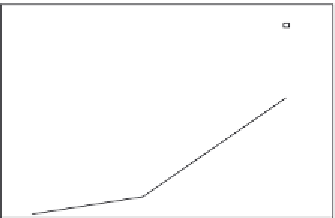Biomedical Engineering Reference
In-Depth Information
100
7
6
80
5
60
4
3
40
2
20
1
0
0
0.8
1
1.2
1.4
1.6
1.8
2
0.8
0.9
1
1.1
1.2
1.3
1.4
1.5
B
Fractal dimension,
D
fd
A
Fractal dimension,
D
f
35
30
25
20
15
10
5
0
0.4
0.6
0.8
1
1.2
1.4
C
D
f
/
D
fd
Figure 8.9
(a) Increase in the binding rate coefficient, k, with an increase in the fractal dimension, D
f
.
(b) Increase in the dissociation rate coefficient, k
d
, with an increase in the fractal dimension, D
fd
.
(c) Increase in the affinity, K (
¼
k/k
d
), with an increase in the fractal dimension dimension ratio,
D
f
/D
fd
.
oxazaborolidine, BNO2 in solution to the FTF immobilized on a SPR biosensor chip surface.
The dissociation rate coefficient,
k
d
, is given by:
2
:
516
0
:
957
k
d
¼ð
3
:
155
2
:
732
Þð
D
fd
Þ
ð
8
:
4b
Þ
The fit is reasonable. Only three data points are available. The availability of more data
points would lead to a more reliable fit. There is scatter in the data. The dissociation rate
coefficient,
k
d
, exhibits an order of dependence slightly higher than two and one-half (equal
to 2.516) on the fractal dimension,
D
fd
, in the dissociation phase or the degree of heterogene-
ity that exists on the SPR biosensor chip surface.
Figure 8.9c
shows the increase in the affinity,
K
(
¼k
/
k
d
), for a single-fractal analysis with an
increase in the ratio of
fractal dimensions,
(
D
f
/
D
fd
),
for
the binding of 0-30 nM
































































































